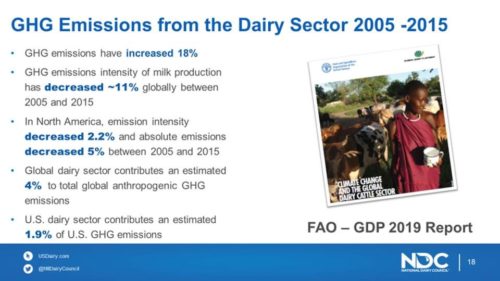How much do cattle contribute to greenhouse gases? It depends on who’s counting, and what.
A couple of weeks ago I did a post about a beef industry ad promoting the idea that eating beef promotes sustainability. The ad claimed that beef contribute only 2% of greenhouse gases. In rebuttal, I cited the widely quoted figure of 14.5%.
Two readers argued for a correction.
The first, Stephen Zwick, describes himself as a “regenetarianist,” a “huge soil nerd,” and independent of industry interests. He sent lengthy and highly technical notes. These, in my interpretation, boil down to:
- The 14.5% figure comes from a study that included land-use change, “specifically in Brazil at peak deforestation rates from 1998 to 2004,” and just for OECD countries.
- In North America, deforestation isn’t a large issue. The 2014 UN Climate Change Conference numbers from countries where land change is not a big factor total 8.1% for all agriculture. Of that, only a quarter is from enteric fermentation (cattle methane burps). Adding in manure management, brings it to about 40% of 8.1% or a bit over 3%.
- These global or regional numbers do not account for soil sinks or tropospheric sinks (elimination of methane). He cites three references: (1) WTF happens to all that methane?, (2) Methane: Accounting for both sides of the scale, (3) Ruminations: Methane math and context
He says:
Enteric methane is a distraction. Poor land management destroying soil sinks and reducing photosynthesis via desertification, deforestation and ocean acidification are also a huge problem. And yes, cattle and palm oil are part of the problem in tropical regions (see The Deforestation Process... )…Cattle is a very conspicuous driver, though it’s not really the primary driver. Human greed is…So, in other words, we need better regional and system data, and we can’t really make universal claims.
The second set of comments comes from Greg Miller, the chief science officer of the National Dairy Council.
While FAO estimates livestock emissions at 14.5% based on LCA [life cycle assessment], the emissions from transportation are only from the tailpipes (not LCA), so comparing apples and bananas – FAO did this, but later retracted because it is an inappropriate comparison, that now keeps getting repeated, thought you should know.
He cites this source on greenhouse gas emissions from the dairy sector:

And he cites this reference: Recht, L. 2021 An Inclusive Transition to a Sustainable and Resilient Meat Sector, which talks about how to raise cattle sustainably.
How to make sense of this?
The percentage of greenhouse gases due to animal agriculture depends on who is doing the counting, and what factors and assumptions go into the estimations. Low estimates predictably come from the beef and dairy industries (Stephen Zwick does not, which is why I am quoting him). The Environmental Protection Agency also produces low estimates: 1.3% of total emissions for dairies.
In contrast, the Humane Society uses 18% (referring to carbon dioxide equivalents), as does Cowspiracy.
A new paper in Sustainability argues that the correct estimate is 16.5%.
It matters whether we are talking about carbon dioxide or methane.
The International Panel on Climate Change (IPCC) recommends “strong, rapid and sustained reductions in CH4 [methane] emissions” and notes that the growth in atmospheric methane is “largely driven by emissions from the fossil fuels and agriculture (dominated by livestock) sectors.”
I was interested to see yesterday’s Politico, which had a report about the current politics of methane emissions. (behind a paywall). It notes:
While oil and gas production is the main reason methane emissions have boomed since 2007, agriculture (namely livestock operations) remains a massive source of the potent greenhouse gas, accounting for 40 percent of methane emissions worldwide. ..Senate Democrats plan to include a “methane polluter fee” in their $3.5 trillion budget resolution that would hit energy producers that vent or burn off excess methane and compressors used to pressurize and transport natural gas.
The precise percentage contributed by animal agriculture? I’m not sure it matters. Everyone agrees that cattle produce more greenhouse gases than produced by any other food (as a result of burps, deforestation, feed production, manure, etc).
Raising cattle more sustainably and regeneratively is a really good idea.
That’s where policy needs to be directed.

